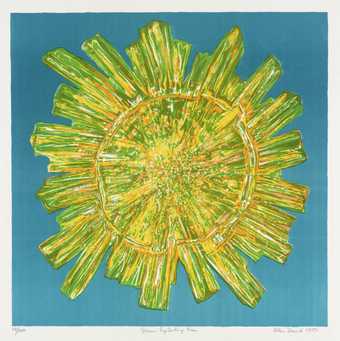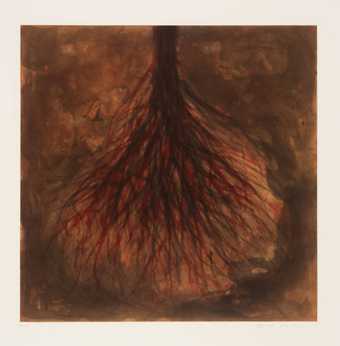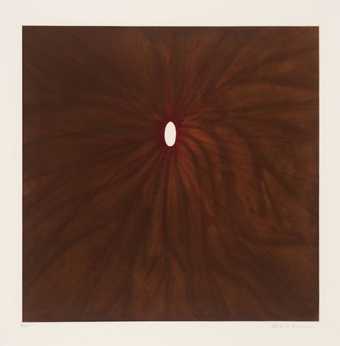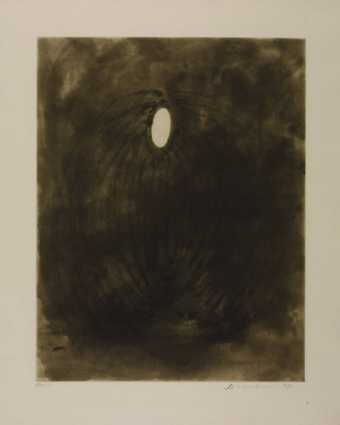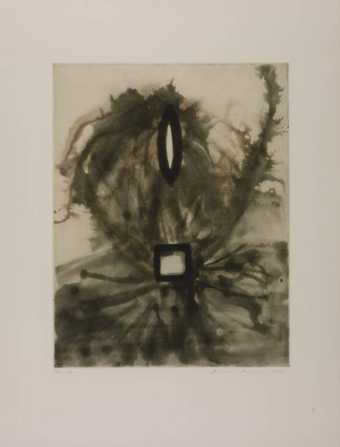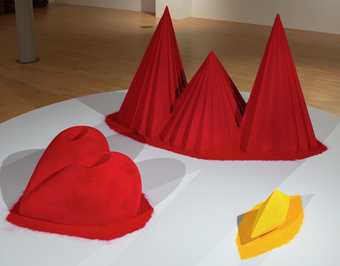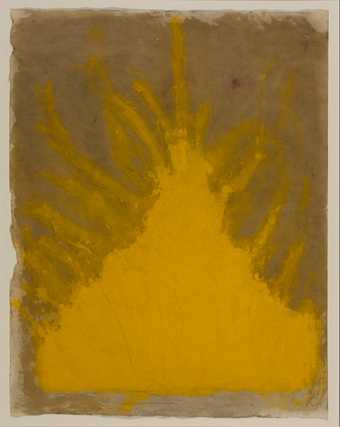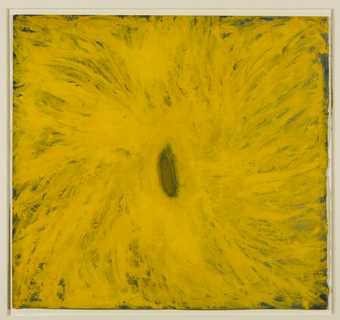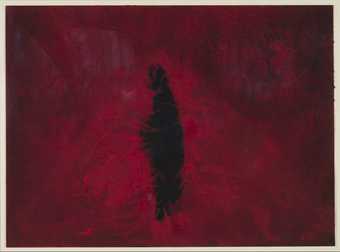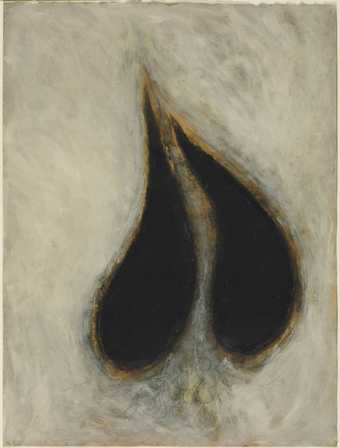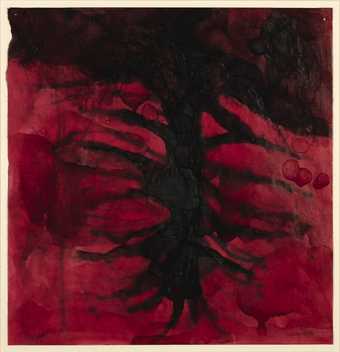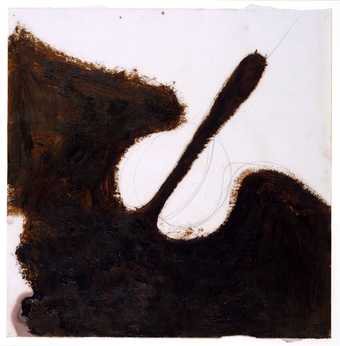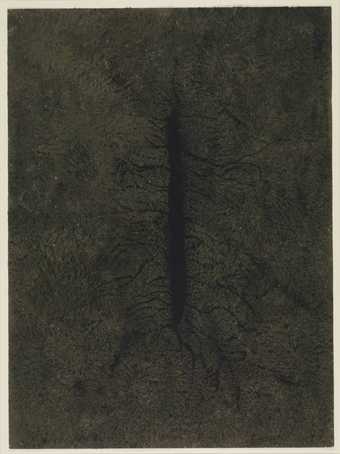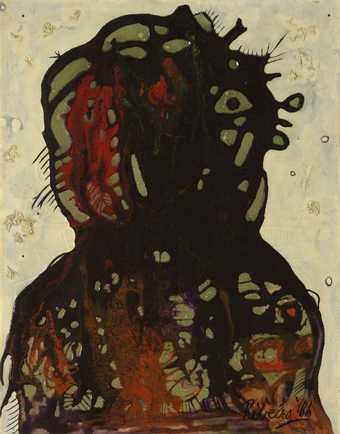
Not on display
- Artist
- Bhupen Khakhar 1934–2003
- Medium
- Oil paint on canvas
- Dimensions
- Support: 1756 × 1756 mm
frame: 1797 × 1810 × 40 mm - Collection
- Tate
- Acquisition
- Purchased 1996
- Reference
- T07200
Summary
You Can’t Please All is a large, square oil painting on canvas by the Indian-born painter Bhupen Khakhar. To the right of the painting an almost life-size figure of a naked man leans over a balcony and surveys a townscape below him, which occupies the majority of the composition. The scene is sparsely populated and painted in cool blues, greys and greens which, along with the dark sky in the top left corner and the lights in the windows of the buildings, evoke twilight. Two figures and a donkey can be seen together in three seemingly separate instances, which appear to represent the same characters at different moments in time, implied by the difference in scale between each depiction. Elsewhere a man tends to his car and figures congregate inside homes. The balcony wall on which the naked man leans has a large section cut out of it, which, along with the visible interiors of the houses and the car door flung wide, gives the scene a sense of openness, heightened by the aerial perspective afforded by the view from the balcony. In contrast to the scene below, the building occupied by the naked man is painted in warmer reds and pinks, which serves to magnify the distinction between the private realm of the man’s abode and the public world outside.
You Can’t Please All was painted in 1981 in Baroda, in Gujarat, India, and took five months to complete. Khakhar only ever worked on one canvas at a time and painted slowly. Beginning by sketching the composition on the canvas in charcoal, Khakhar would then paint using small- or medium-sized brushes with the canvas laid flat on the floor. Khakhar believed that ‘It is ultimately the colour which determines the painting’ and he went to painstaking lengths to achieve the colours he wanted. The final touches would often involve applying pigment straight from the tube, contributing to the extreme thickness of the paint in some areas of his canvases.
The title of this work comes from one of Aesop’s fables in which a father and son take their donkey to market. As the pair set out on their journey, someone they pass queries why neither of them is riding the donkey, so the older man puts his son on the donkey, only to be asked by another passer-by why the younger boy rides while his old father walks. As a result the man gets onto the donkey with his son only to be jeered at again for overloading the animal. The father and son then both get off the donkey and devise a plan to carry it by tying it to a long pole. The town crowd laughs at them as they cross a bridge and, as the donkey wriggles and writhes, the boy drops his end of the pole and the donkey falls into water below and drowns. An old man who followed them on their journey concludes the story by remarking: ‘Please all, and you will please none!’ In Khakar’s painting different episodes from the fable can be identified, presenting a continuous narrative that weaves through the townscape. This pictorial device recalls the way stories were depicted in early Renaissance paintings, which Khakhar greatly admired.
Khakhar trained as an accountant before studying painting in Baroda. His paintings draw upon different visual traditions, incorporating the colours and detailing of Indian miniatures and the boldness of Western pop art. During the 1970s Khakhar regularly painted tradesmen at work, but in the 1980s he began to engage with proverbs, and the narrative dimension of his work took on greater importance. A short while after making this painting Khakhar revealed that the naked male figure was himself and that this piece represented his coming-out as a homosexual (see Hyman 1998, p.69). The personal difficulties he faced at the time are suggested by the work’s title, which implies that people he encountered did not accept his sexuality.
The British painter Dexter Dalwood, who lived in Baroda between 1985 ad 1986 and knew Khakhar, has written of You Can’t Please All:
The naked figure on the balcony is internally separate from the society depicted, and yet at the same time, absolutely a part of the complex life which makes up the contradiction that is modern India. This way of combining complex emotional feelings, within an image which attempts to present a whole nervous-system, I find to be incredibly inspiring – and liberating.
(Hyman 1998, p.67)
You Can’t Please All was first exhibited as part of a group show titled Place for People, which toured from Bombay to New Delhi in 1981. The exhibition is now considered a turning point in Indian art as it marked a move away from symbolic and abstract imagery towards contemporary and personal subjects. It is also considered the beginning of the Baroda School, a loose grouping of figurative painters that includes Gulam Sheikh and Sudhir Patwardhan.
Further reading
Mahendra Desai, A Man Labelled Bhupen Khakhar Branded as Painter, Baroda 1983.
Bhupen Khakhar, exhibition catalogue, Centre Pompidou, Paris 1986, reproduced p.20.
Timothy Hyman, Bhupen Khakhar, Bombay 1998, pp.66–9, reproduced pp.82–3.
Rebecca Heald
May 2014
Supported by Christie’s.
Does this text contain inaccurate information or language that you feel we should improve or change? We would like to hear from you.
Display caption
Gallery label, August 2004
Does this text contain inaccurate information or language that you feel we should improve or change? We would like to hear from you.
Technique and condition
Khakhar has employed a standard stretched cotton duck canvas with an oil type, white priming for what is slightly unusual, a square format. It is inscribed on the back of the canvas that oil paint has been used.
The paint appears to have been worked on for an extended period. Changes in composition are visible where colour or thick underlayers show through surface paint. Brush marks are visible, but the surface has been smoothed. Where only one or two paint layers are present, the canvas texture shows, but where greater thicknesses are present, the paint surface has an enamel like appearance. Perhaps as a result of its thickness, some drying cracks have formed in some areas. The thickness of the film may have slowed the drying of the film allowing the cracks to develop. Some of the areas covered by the thickest paint are also the most glossy, indicating that additional binder has been mixed in with the paint.
No varnish is apparent. From dates written on the back of the canvas, the painting was executed over five months.
Tim Green
October 1998
Explore
- architecture(30,960)
- residential(5,553)
-
- house(2,675)
- townscapes / man-made features(21,603)
- classical(198)
- actions: processes and functions(2,161)
-
- looking / watching(581)
- man(10,453)
- Asian(117)
- male(959)
- self-portraits(888)
- countries and continents(17,390)
-
- India(166)
- nationality(18,601)
-
- Indian(127)
- arts and entertainment(7,210)
-
- artist, painter(2,545)
You might like
-
Allen David Green Exploding Sun
1970 -
Sir Anish Kapoor CBE RA Untitled
1989 -
Sir Anish Kapoor CBE RA Untitled
1989 -
Sir Anish Kapoor CBE RA Untitled 2
1988 -
Sir Anish Kapoor CBE RA Untitled 3
1988 -
Sir Anish Kapoor CBE RA As if to Celebrate, I Discovered a Mountain Blooming with Red Flowers
1981 -
Sir Anish Kapoor CBE RA Untitled
1987 -
Sir Anish Kapoor CBE RA Untitled
1989 -
Sir Anish Kapoor CBE RA Untitled
1990 -
Sir Anish Kapoor CBE RA Untitled
1986 -
Sir Anish Kapoor CBE RA Untitled
1989 -
Sir Anish Kapoor CBE RA Untitled
1989 -
Sir Anish Kapoor CBE RA Untitled
1989 -
Lancelot Ribeiro The Warlord (Psychedelic Man Series)
1966 -
Lancelot Ribeiro Cityscape (Night)
1963

